Fortinet NSE 7 - SD-WAN 6.4 v1.0
Question 1
Which statement about using BGP routes in SD-WAN is true?
- A. Adding static routes must be enabled on all ADVPN interfaces.
- B. VPN topologies must be form using only BGP dynamic routing with SD-WAN.
- C. Learned routes can be used as dynamic destinations in SD-WAN rules.
- D. Dynamic routing protocols can be used only with non-encrypted traffic.
Answer : C
Reference:
https://www.fortinetguru.com/2019/09/using-bgp-tags-with-sd-wan-rules-fortios-6-2/#:~:text=SD%2DWAN%20rules%20can%20use,to%20the%20customer's%
20data%20center
.
Question 2
An administrator is troubleshooting VoIP quality issues that occur when calling external phone numbers. The SD-WAN interface on the edge FortiGate is configured with the default settings, and is using two upstream links. One link has random jitter and latency issues, and is based on a wireless connection.
Which two actions must the administrator apply simultaneously on the edge FortiGate to improve VoIP quality using SD-WAN rules? (Choose two.)
- A. Select the corresponding SD-WAN balancing strategy in the SD-WAN rule.
- B. Choose the suitable interface based on the interface cost and weight.
- C. Use the performance SLA targets to detect latency and jitter instantly.
- D. Place the troublesome link at the top of the interface preference list.
- E. Configure an SD-WAN rule to load balance all traffic without VoIP.
Answer : AC
Question 3
Refer to exhibits.
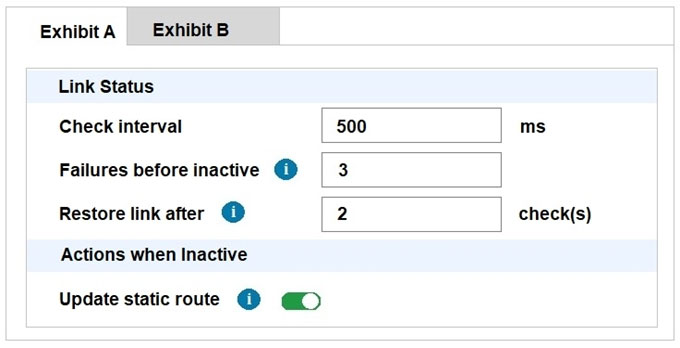
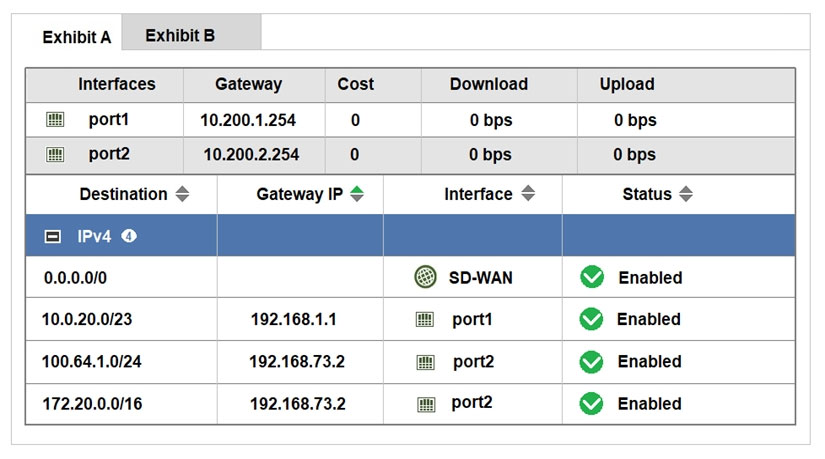
Exhibit A shows the SD-WAN performance SLA and exhibit B shows the SD-WAN interface and the static routes configuration.
Port1 and port2 are member interfaces of the SD-WAN, and port2 becomes a dead member after reaching the failure thresholds.
Which statement about the dead member is correct?
- A. Port2 might become alive when a single response is received from an SLA server.
- B. Dead members require manual administrator access to bring them back alive.
- C. Subnets 100.64.1.0/24 and 172.20.0.0/16 are reachable only through port1.
- D. SD-WAN interface becomes disabled and port1 becomes the WAN interface.
Answer : C
Question 4
What are two roles that SD-WAN orchestrator plays when it works with FortiManager? (Choose two.)
- A. It configures and monitors SD-WAN networks on FortiGate devices that are managed by FortiManager.
- B. It acts as a standalone device to assist FortiManager to manage SD-WAN interfaces on the managed FortiGate devices.
- C. It acts as a hub FortiGate with an SD-WAN interface enabled and managed along with other FortiGate devices by FortiManager.
- D. It acts as an application that is released and signed by Fortinet to run as a part of management extensions on FortiManager.
Answer : BD
Question 5
Refer to the exhibit.
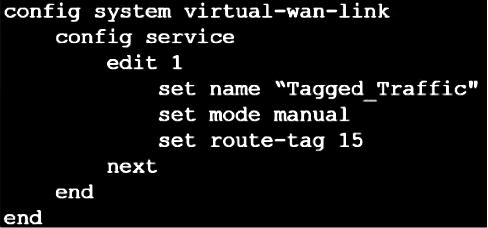
Which statement about the command route-tag in the SD-WAN rule is true?
- A. It ensures route tags match the SD-WAN rule based on the rule order.
- B. It tags each route and references the tag in the routing table.
- C. It enables the SD-WAN rule to load balance and assign traffic with a route tag.
- D. It uses route tags for a BGP community and assigns the SD-WAN rules with same tag.
Answer : A
Reference:
https://docs.fortinet.com/document/fortigate/6.2.9/cookbook/672387/using-bgp-tags-with-sd-wan-rules
Question 6
Which two configuration tasks are required to use SD-WAN? (Choose two.)
- A. Add one or more members to an SD-WAN zone.
- B. Configure at least one firewall policy for SD-WAN traffic.
- C. Specify the outgoing interface routing cost.
- D. Specify the incoming interfaces in SD-WAN rules.
Answer : AB
Question 7
Refer to the exhibit.

Which statement about the ADVPN device role in handling traffic is true?
- A. This is a spoke that has received a query from a remote hub and has forwarded the response to its hub.
- B. Two hubs, 10.1.1.254 and 10.1.2.254, are receiving and forwarding queries between each other.
- C. Two spokes, 100.64.3.1 and 10.1.2.254, forward their queries to their hubs.
- D. This is a hub that has received a query from a spoke and has forwarded it to another spoke.
Answer : B
Question 8
Which two statements describe how IPsec phase 1 main mode id different from aggressive mode when performing IKE negotiation? (Choose two.)
- A. A peer ID is included in the first packet from the initiator, along with suggested security policies.
- B. XAuth is enabled as an additional level of authentication, which requires a username and password.
- C. Three packets are exchanged between an initiator and a responder instead of six packets.
- D. The use of Diffie Hellman keys is limited by the responder and needs initiator acceptance.
Answer : AC
Question 9
Refer to the exhibit.
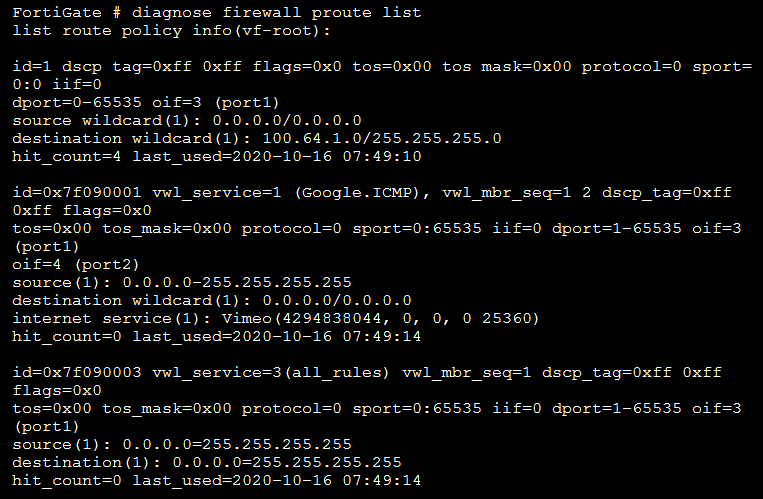
Based on the output, which two conclusions are true? (Choose two.)
- A. The all_rules rule represents the implicit SD-WAN rule.
- B. There is more than one SD-WAN rule configured.
- C. Entry 1 (id=1) is a regular policy route.
- D. The SD-WAN rules takes precedence over regular policy routes.
Answer : AC
Question 10
Which diagnostic command can you use to show the SD-WAN rules interface information and state?
- A. diagnose sys sdwan route-tag-list.
- B. diagnose sys sdwan service.
- C. diagnose sys sdwan member.
- D. diagnose sys sdwan neighbor.
Answer : B
Reference:
https://docs.fortinet.com/document/fortigate/6.2.0/cookbook/818746/sd-wan-related-diagnose-commands
Question 11
Which two protocols in the IPsec suite are most used for authentication and encryption? (Choose two.)
- A. Internet Key Exchange (IKE)
- B. Secure Shell (SSH)
- C. Security Association (SA)
- D. Encapsulating Security Payload (ESP)
Answer : AD
Question 12
What are two reasons for using FortiManager to organize and manage the network for a group of FortiGate devices? (Choose two.)
- A. To improve SD-WAN performance on the managed FortiGate devices
- B. To send probe packets as health checks to the beacon servers on behalf of FortiGate
- C. To simplify the deployment and administration of SD-WAN on managed FortiGate devices
- D. To reduce WAN usage on FortiGate devices by acting as a local FortiGuard server
Answer : AC
Question 13
In which two ways does FortiGate learn the FortiManager IP address or FQDN for zero-touch provisioning? (Choose two.)
- A. From a FortiGuard definitions update
- B. From the central management configuration configured in FortiDeploy
- C. From a DHCP server configured with options 240 or 241
- D. From another FortiGate device in the same local network
Answer : AD
Question 14
Refer to exhibits.
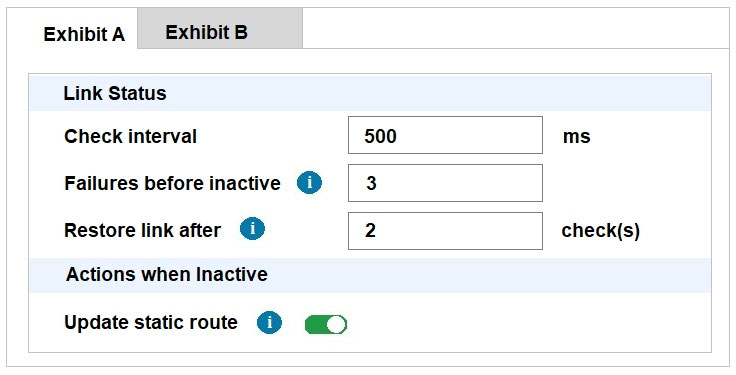

Exhibit A, which shows the SD-WAN performance SLA and exhibit B shows the health of the participating SD-WAN members.
Based on the exhibits, which statement is correct?
- A. The dead member interface stays unavailable until an administrator manually brings the interface back.
- B. Port2 needs to wait 500 milliseconds to change the status from alive to dead.
- C. Static routes using port2 are active in the routing table.
- D. FortiGate has not received three consecutive requests from the SLA server configured for port2.
Answer : C
Question 15
Refer to the exhibit.

Which two conclusions for traffic that matches the traffic shaper are true? (Choose two.)
- A. The traffic shaper drops packets if the bandwidth exceeds 6250 KBps.
- B. The traffic shaper limits the bandwidth of each source IP to a maximum of 6250 KBps.
- C. The traffic shaper drops packets if the bandwidth is less than 2500 KBps.
- D. The measured bandwidth is less than 100 KBps.
Answer : BD